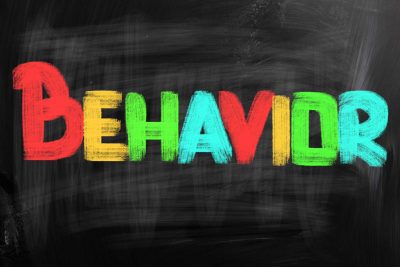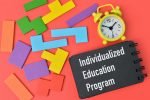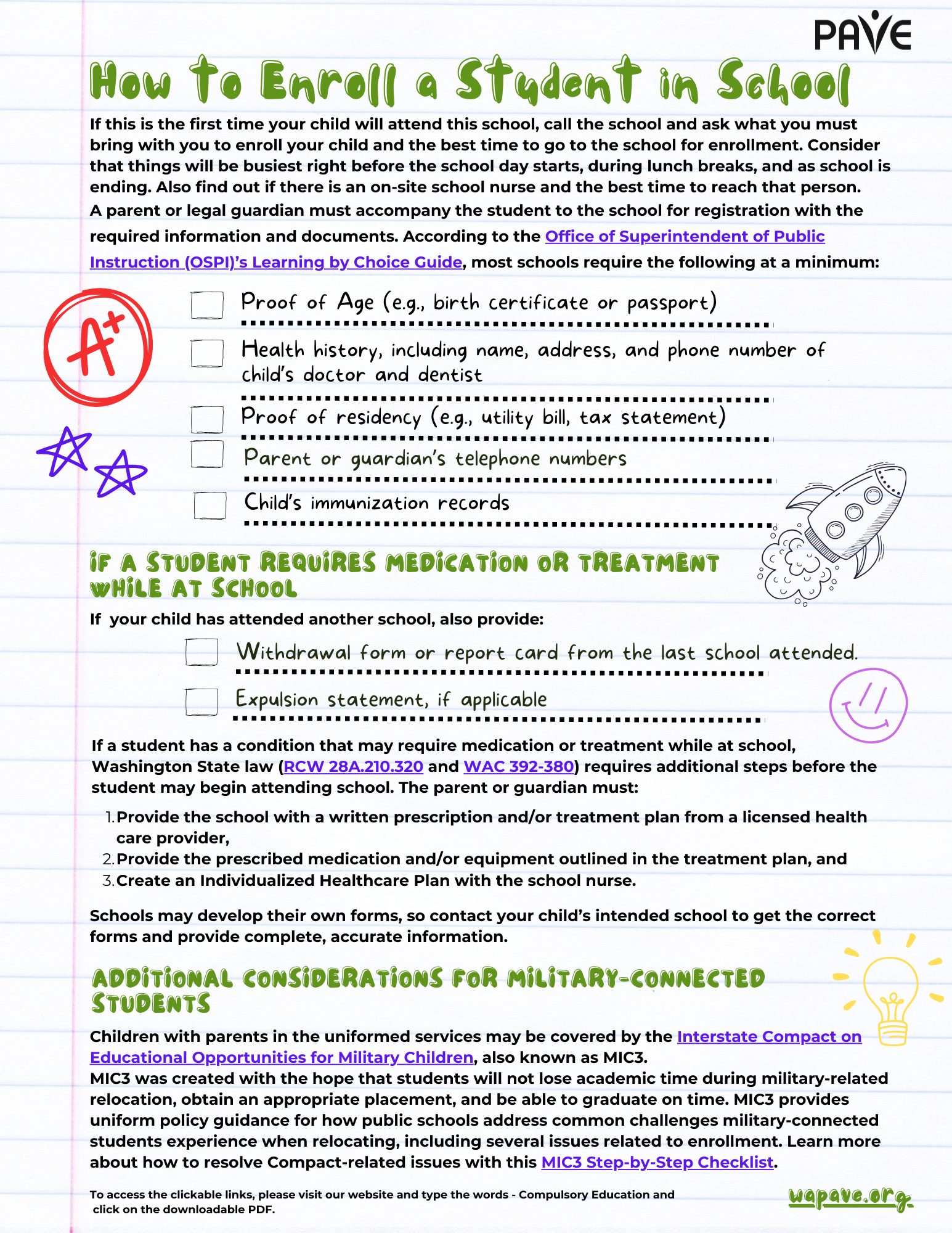Behavior is a form of communication, and children often try to express their needs and wants more through behavior than words. When a young person has a disability or has experienced trauma or other distress, adults and authorities may need to put in extra effort to understand. Missed cues and unmet needs can result in unexpected and sometimes explosive behaviors, which may lead schools to suspend or expel students. Schools are required to address students’ behavioral health needs and limit use of punitive discipline.
Unfortunately, not all students are adequately supported. State data indicate that students with disabilities are disciplined at least 2.5 times more often than non-disabled peers (See WA State Report Card). For students with disabilities who are Black, Indigenous, or People of Color (BIPOC), the numbers are consistently higher within Washington State and nationwide.
A Brief Overview
- Schools are responsible to teach expected behavior and limit use of punitive discipline. In July 2022, the US Department of Education’s Office for Civil Rights issued guidance about the rights of students with behavioral health needs. Available in multiple languages, the booklet is titled: Supporting Students with Disabilities and Avoiding the Discriminatory Use of Student Discipline under Section 504 of the Rehabilitation Act of 1973. Keep in mind that Section 504 protects all students with disabilities within the public school system, including those with Section 504 Plans, those with Individualized Education Programs (IEPs), and those with known or suspected disability conditions that make schools responsible to evaluate them. Read on for more information and highlights from this 40-page OCR document.
- The federal Office of Special Education Programs (OSEP) also issued guidance in July 2022 that describes federal work underway to improve behavioral supports and reduce disciplinary removal of students receiving special education services. OSEP’s Dear Colleague Letter includes links to a Q and A document about disciplinary requirements and A Guide for Stakeholders.
- Washington State’s Office of Superintendent of Public Instruction (OSPI) provides state-specific information about Discipline Procedures for Students Eligible to Receive Special Education Services.
- To know more about student and family rights, refer to the Procedural Safeguards.
- PAVE provides a Behavioral Health Toolkit that includes a video to support development of a Behavior Intervention Plan (BIP).
- Families can seek individualized assistance by clicking Get Help from PAVE’s website, wapave.org.
Introduction
By many state and national measures, children’s behavioral health worsened during the pandemic and many children are developmentally behind in social, emotional, and behavioral skills. Governor Jay Inslee on March 14, 2021, issued an emergency proclamation declaring children’s mental health to be in crisis. At the same time, many schools and behavioral health agencies struggle to meet rising demand for services. PAVE provides a toolkit with further information about options for assisting children and young people with behavioral health conditions and ways to advocate for system change in Washington State.
This article provides information about school discipline. Keep in mind that disability rights protect individuals with all disabilities, including behavioral health disabilities. School policies and practices related to discipline may not discriminate against students, regardless of the nature or severity of the disability condition. Federal and state laws require that students with disabilities receive support and individualized instruction to help them meet behavioral expectations (WAC 392-172A-03110).
Federal and state guidance is written for schools and can help families too
This article includes links to various federal and state guidance documents that are written primarily to help school leaders follow laws that protect the rights of students with disabilities. Families and community members can refer to this guidance and work to help ensure that their local schools follow the law. When this does not happen, families and community members can use the dispute resolution process and incorporate federal and state guidance to support their advocacy efforts.
Dispute Resolution options related to IEP process are described in Procedural Safeguards. Dispute Resolution options when there are civil rights issues are described in the Section 504 Notice of Parent Rights. Both links connect to places where these documents are downloadable in various languages.
Key guidance and legal protections
Here are key state and national resources related to school discipline:
Washington State’s Office of Superintendent of Public Instruction (OSPI) provides information about Discipline Procedures for Students Eligible to Receive Special Education Services.
The Office of Special Education Programs (OSEP) within the US Department of Education issued a guidance letter July 19, 2022, that describes federal work underway to improve behavioral supports and reduce use of disciplinary removal nationwide. OSEP’s Dear Colleague Letter includes links to a Q and A document about disciplinary requirements and A Guide for Stakeholders, describing best practices to support behavior.
Also in July 2022, the US Department of Education’s Office for Civil Rights (OCR) issued guidance about the rights of students with behavioral health needs. Available in multiple languages, the downloadable booklet is titled: Supporting Students with Disabilities and Avoiding the Discriminatory Use of Student Discipline under Section 504 of the Rehabilitation Act of 1973.
In a Dear Colleague letter published with OCR’s guidance on July 19, 2022, Catherine E. Lhamon, Assistant Secretary for Civil Rights, calls out problems related to disability discrimination. “An important part of [OCR’s] mission is to ensure that students are not denied equal educational opportunity or subjected to discrimination based on their disabilities, including through the improper use of discipline,” Sec. Lhamon wrote.
Behavior support is part of FAPE
The right to appropriate behavioral supports is part of a student’s right to a Free Appropriate Public Education (FAPE), which requires services and supports designed to meet identified needs so students with disabilities can access what non-disabled students access without individualized services.
OCR’s guidance includes information about what schools must provide to serve FAPE, including the responsibility to offer regular and/or special education, and related aids and services, that “are designed to meet the student’s individual educational needs as adequately as the needs of students without disabilities are met.”
Qualified personnel are required for FAPE: “Schools must take steps to ensure that any staff responsible for providing a student with the services necessary to receive FAPE understand the student’s needs and have the training and skills required to implement the services. A school’s failure to provide the requisite services is likely to result in a denial of FAPE.”
FAPE violations under Section 504 relate to fundamental disability rights. Denial of those rights is considered disability discrimination, which OCR defines as “excluding, denying benefits to, or otherwise discriminating against a student based on their disability, including by denying them equal educational opportunity in the most integrated setting appropriate to their needs.”
Federal framework for student rights
Families can empower themselves to understand these rights and resources and advocate for their students by learning the federal framework for school-based services:
- Students who receive accommodations and supports through a Section 504 Plan have anti-discrimination protections from the Rehabilitation Act of 1973.
- Students with an Individualized Education Program (IEP) have Section 504 protections and specific rights and protections from the Individuals with Disabilities Education Act (IDEA).
- Section 504 protects all students with disabilities within the public school system, including those with Section 504 Plans, those with IEPs, and those with known or suspected disability conditions that make schools responsible to evaluate them. The right to a non-discriminatory evaluation is protected by Section 504 and by IDEA’s Child Find Mandate.
- Section 504 applies to elementary and secondary public schools (including public charter schools and state-operated schools), public school districts, State Educational Agencies (OSPI is the SEA for WA State), and private schools and juvenile justice residential facilities that receive federal money directly or indirectly from the Department of Education. Private schools that do not receive federal funding are not bound by IDEA.
- Title VI of the Civil Rights Act of 1964 prohibits discrimination based on race, color, or national origin. According to its July 2022 guidance, OCR can investigate complex complaints: “OCR is responsible for enforcing several laws that prohibit schools from discriminating based on disability; race, color, or national origin; sex; and age. A student may experience multiple forms of discrimination at once. In addition, a student may experience discrimination due to the combination of protected characteristics, a form of discrimination often called intersectional discrimination. Some instances of intersectional discrimination may stem from a decisionmaker acting upon stereotypes that are specific to a subgroup of individuals, such as stereotypes specific to Black girls that may not necessarily apply to all Black students or all girls. When OCR receives a complaint alleging discrimination in the use of discipline under more than one law, OCR has the authority to investigate and, where appropriate, find a violation under any law in its jurisdiction.” [emphasis added]
- Contact the Office for Civil Rights (OCR) at OCR@ed.gov or by calling 800-421-3481 (TDD: 800-877- 8339).
What is exclusionary discipline?
Any school disciplinary action that takes a student away from their regularly scheduled placement at school is called exclusionary discipline. Out-of-school suspensions, expulsions, and in-school suspensions count. Shortened school days and informal removals—like when the school calls parents to have a child taken home for their behavior—are forms of exclusionary discipline unless there is a school-and-family meeting in which an alternate placement or schedule is chosen to best meet the needs of the student.
If such a meeting does take place, the school and family team are responsible to make decisions about program and placement that are individualized. Schools may not unilaterally decide, for example, that all students with certain behavioral characteristics should attend a specific school or program. According to OCR, “A school district would violate Section 504 if it had a one-size-fits-all policy that required students with a particular disability to attend a separate class, program, or school regardless of educational needs.”
Seclusion and restraint may not be used as punishment
Seclusion (also called isolation) and/or restraint are emergency responses when there is severe and imminent danger. Federal guidance emphasizes that these practices may never be used as punishment or discipline:
“OSEP is not aware of any evidence-based support for the view that the use of restraint or seclusion is an effective strategy in modifying a child’s behaviors that are related to their disability. The Department’s longstanding position is that every effort should be made to prevent the need for the use of restraint or seclusion and that behavioral interventions must be consistent with the child’s rights to be treated with dignity and to be free from abuse.”
More information about isolation and restraint is included later in this article.
Exclusionary discipline may violate FAPE, including for students not yet receiving services
A student with an identified disability may be suspended for a behavioral violation that is outlined in district policy. The student “code of conduct” usually explains what it takes to get into trouble.
Schools are limited in their ability to exclude students from school because of behaviors that “manifest” (arise or express) from disability. Federal and state guidance is for schools to suspend students only if there are significant safety concerns.
If a student with disabilities has unmet needs and is consistently sent home instead of helped, the school may be held accountable for not serving the needs. According to OCR, disability discrimination can include instances when there is reasonable suspicion that a disability condition is impacting behavior, but the student is not properly evaluated to see if they are eligible for services and what services they may need.
The right to evaluation is protected by Child Find, which is an aspect of the IDEA, as well as Section 504 of the Rehabilitation Act of 1973. OCR guidance includes information that schools may need to train or hire experts to meet federal requirements: “To ensure effective implementation of its evaluation procedures, a school may need to provide training to school personnel on when a student’s behaviors, or other factors, indicate the need for an evaluation under Section 504.”
A student with a disability that impacts their learning is entitled to FAPE. Again, FAPE stands for Free Appropriate Public Education. FAPE is protected by Section 504 and by IDEA. FAPE is what a student with disabilities is entitled to receive and what schools are responsible to provide.
OCR provides these places to look for data demonstrating a need to evaluate and determine whether a student is entitled to the rights and protections of FAPE:
- Information or records shared during enrollment
- Student behaviors that may harm the student or another person
- Observations and data collected by school personnel
- Information voluntarily provided by the student’s parents or guardians
- The school’s own disciplinary or other actions indicating that school personnel have concerns about the student’s behavior, such as frequent office referrals, demerits, notes to parents or guardians, or use of restraints or seclusion
- Information that a previous response to student behavior by school personnel resulted in repeated or extended removals from educational instruction or services, or that a previous response (such as a teacher’s use of restraints or seclusion) traumatized a student and resulted in academic or behavioral difficulties
Schools are required to take assertive action to evaluate a student and/or reconsider the services plan if the student is consistently missing school because of their behavior. OCR guidance clearly states that schools cannot use resource shortages as a reason to deny or delay an evaluation:
“OCR would likely find it unreasonable for a district to delay a student’s evaluation because it does not have sufficient personnel trained to perform the needed assessments and fails to secure private evaluators to meet the need. In addition, the fact that a student is doing well academically does not justify the school denying or delaying an evaluation when the district has reason to believe the student has a disability, including if the student has disability-based behavior resulting in removal from class or other discipline (e.g., afterschool detentions).”
Parents can request an evaluation any time
OCR’s guidance states that parents can request an evaluation at public expense any time. “Section 504 does not limit the number of evaluations a student may reasonably request or receive. The student’s parent or guardian is entitled to notice of the school’s decision and may challenge a denial of their request under Section 504’s procedural safeguards.”
Despite a parent’s right to request an evaluation, the school is responsible to evaluate a child if there is reason to believe a disability is disrupting education: “While parents or guardians may request an evaluation, and schools must respond to any such requests, the responsibility to timely identify students who may need an evaluation remains with the school.”
Procedural Safeguards include detail about the evaluation process and the right to an Independent Educational Evaluation (IEE) if the district’s evaluation is incomplete or if parents disagree with its conclusions or recommendations.
Manifestation Determination
Schools are required to document missed educational time and meet with family to review the student’s circumstances. These requirements are related to the provision of FAPE (Free Appropriate Public Education) for students with disabilities. If the time a student with disabilities is removed from their academic placement for discipline adds up to 10 days, the school is required to host a specific meeting called a Manifestation Determination.
OCR guidance states that discussion about what happened and what to do next must be made by a team of people knowledgeable about the student’s needs and disability: “If a single person, such as a principal who is in charge of the school’s general disciplinary process for all students, alone determined whether a student’s behavior was based on the student’s disability, such a unilateral decision would not comply with Section 504.”
The Manifestation Determination requirement includes informal or “off book” removals from school. For example, if the school calls and directs parents to take a child home because of behavior, that missed educational time counts toward the 10 days. Parents can request paperwork to document the missed time to ensure compliance with this requirement. OCR guidance includes this statement:
“OCR is aware that some schools informally exclude students, or impose unreasonable conditions or limitations on a student’s continued school participation, as a result of a student’s disability-based behaviors in many ways, such as:
- Requiring a parent or guardian not to send their child to, or to pick up their child early from, school or a school-sponsored activity, such as a field trip;
- Placing a student on a shortened school-day schedule without first convening the Section 504 team to determine whether such a schedule is necessary to meet the student’s disability-specific needs;
- Requiring a student to participate in a virtual learning program when other students are receiving in-person instruction;
- Excluding a student from accessing a virtual learning platform that all other students are using for their instruction;
- Informing a parent or guardian that the school will formally suspend or expel the student, or refer the student to law enforcement, if the parent or guardian does not: pick up the student from school; agree to transfer the student to another school, which may be an alternative school or part of a residential treatment program; agree to a shortened school day schedule; or agree to the use of restraint or seclusion; and
- Informing a parent or guardian that the student may not attend school for a specific period of time or indefinitely due to their disability-based behavior unless the parent or guardian is present in the classroom or otherwise helps manage the behavior (e.g., through administering medication to the child).
“Depending on the facts and circumstances, OCR could find that one or more of these practices violate Section 504.”
Under Section 504, schools are bound to consider disability-related factors through Manifestation Determination if the disciplinary removal is for more than 10 consecutive school days or when the child is subjected to a series of removals that constitute a pattern. For state-specific information, OSPI provides a guidance form for Section 504 circumstances.
For a student with an IEP, removal from regularly scheduled classes for more than 10 days per school year may constitute a “change of placement” if there is a pattern to the removals and the behaviors are similar in nature (WAC 392-172A-05155). In those situations, a Manifestation Determination meeting is held to determine whether the disciplinary removals resulted from the school’s failure to implement the IEP. OSPI provides a guidance form for IEP circumstances.
Note that Manifestation Determination is a distinct process for students with known or suspected disabilities and is separate from general education disciplinary hearings or procedures. Under federal requirements (IDEA Sec. 300.530 (e)), the behavior must be determined to manifest from disability if the IEP Team determine that the behavior was:
- Caused by, or had a direct and substantial relationship to, the student’s disability
- The direct result of the school’s failure to implement the IEP, including situations where the child did not consistently receive all services required by their IEP
A behavior support plan is best practice
During a Manifestation Determination meeting, a student’s circumstances and services are reviewed. An IEP can be amended to provide additional support and a Functional Behavioral Assessment is planned to gather information for a Behavior Intervention Plan (BIP). If the student has a BIP that isn’t working, the plan can be changed. See PAVE’s video: Behavior and School: How to Participate in the FBA/BIP Process.
For students without IEP services, a Manifestation Determination meeting can initiate or expedite an educational evaluation in addition to an FBA. If the school district knew or should have known that the student needed special education services and did not initiate an evaluation, Child Find violations may apply.
Family members are included in this process. According to WAC 392-172A-05146, “If the school district, the parent, and relevant members of the student’s IEP team determine the conduct was a manifestation of the student’s disability, the school district must take immediate steps to remedy those deficiencies.”
If the conduct is determined to be unrelated to disability, then school personnel may use general education discipline procedures. The school must still provide any special education services that the student has already been found to need. The IEP team decides the appropriate alternative setting and special education services to meet the student’s needs while suspended.
A shortened school day may be a suspension
If the school reduces a student’s schedule because of difficult-to-manage behaviors, the change could be considered a suspension and the missed educational time could count toward a Manifestation Determination process. OSPI provides this information in a Technical Assistance Paper (TAP #2):
“A decision to shorten a student’s school day in response to a behavioral violation would constitute a suspension under general state discipline regulations (WAC 392-400-025).
“District authorities should not use a shortened school day as an automatic response to students with challenging behaviors at school or use a shortened day as a form of punishment or as a substitute for a BIP [Behavior Intervention Plan]. An IEP team should consider developing an IEP that includes a BIP describing the use of positive behavioral interventions, supports, and strategies reasonably calculated to address the student’s behavioral needs and enable the student to participate in the full school day.”
OSEP’s federal guidance explains that a shortened school day is a disciplinary removal unless the IEP team has explored all options to serve the student with a full day and agreed that a shortened day is the only adequate option so the student can benefit from their Free Appropriate Public Education (FAPE):
“[The] practice of shortening a child’s school day as a disciplinary measure could be considered a denial of FAPE if the child’s IEP Team does not also consider other options such as additional or different services and supports that could enable a child to remain in school for the full school day.”
OCR’s guidance points out that a shortened school day is an example of a significant change of placement, and that placement changes require a re-evaluation process: “Section 504 requires reevaluations on a periodic basis, in addition to a subsequent evaluation before any significant change in placement.”
A school’s decision to keep a student out of school is separate from a student or family decision for the student to stay home to care for their mental health. In 2022, the Washington Legislature passed HB 1834, which establishes a student absence from school for mental health reasons as an excused absence.
Alternative learning options for longer suspensions
If a student’s behavioral violation includes weapons or illegal substances, or causes severe injury, the school can remove the student from their placement for longer than 10 days, regardless of their disability. Those situations are referred to as “Special Circumstances.”
Some Section 504 protections do not apply when a school disciplines a student with a disability because of current drug or alcohol use. According to OCR, “Schools may discipline a student with a disability who is currently engaging in the illegal use of drugs or the use of alcohol to the same extent that the school disciplines students without disabilities for this conduct.”
OCR goes on to say that Section 504 protections apply to students who:
- Successfully complete a supervised drug rehabilitation program or are otherwise rehabilitated successfully and no longer engaging in the illegal use of drugs
- Are participating in a supervised rehabilitation program and are no longer using
- Were erroneously [incorrectly] regarded as engaging in substance use
Under Special Circumstances, a student might shift into an Interim Alternative Educational Setting (IAES) for up to 45 school days, regardless of whether the violation was caused by disability related behaviors. The following information from federal law uses a couple of acronyms not previously defined in this article:
- SEA is a State Educational Agency (OSPI is the SEA for Washington State)
- LEA is a Lead Educational Agency, which in our state refers to a school district
Under federal law (34 C.F.R. § 300.530(g)):
School personnel may consider removing a child with a disability from their current placement and placing them in an IAES for not more than 45 school days without regard to whether the behavior is determined to be a manifestation of the child’s disability if the child:
- Carries a weapon to or possesses a weapon at school, on school premises, or to or at a school function under the jurisdiction of an SEA or an LEA
- Knowingly possesses or uses illegal drugs or sells or solicits the sale of a controlled substance, while at school, on school premises, or at a school function under the jurisdiction of an SEA or an LEA
- Has inflicted serious bodily injury upon another person while at school, on school premises, or at a school function under the jurisdiction of an SEA or an LEA
The temporary setting (IAES) is chosen by the IEP team and must support the student’s ongoing participation in the general education curriculum as well as progress toward IEP goals. As appropriate, the student’s behavior is assessed through the Functional Behavioral Assessment (FBA—see below) while they are learning in the alternate setting, so a behavior plan is in place to prevent future problems when the student returns to their regular schedule and classes.
If the school pursues a threat/risk assessment, they are required to safeguard a student’s right to be treated in non-discriminatory ways. According to OCR, “Schools can do so by ensuring that school personnel who are involved in screening for and conducting threat or risk assessments for a student with a disability are aware that the student has a disability and are sufficiently knowledgeable about the school’s FAPE responsibilities so that they can coordinate with the student’s Section 504 [or IEP] team….
“For example, the Section 504 [or IEP] team can provide valuable information about: the nature of the student’s disability-based behaviors and common triggers; whether the student has been receiving behavioral supports, and, if so, the effectiveness of those supports; and specific supports and services that may be able to mitigate or eliminate the risk of harm without requiring exclusion from school.”
Schools are required to support behavior and work with families
Schools are required to provide education and support before resorting to discipline for children who struggle with behavior because of their impairments. According to OCR, “Individualized behavioral supports may include, among other examples: regular group or individual counseling sessions, school social worker services, school-based mental health services, physical activity, and opportunities for the student to leave class on a scheduled or unscheduled basis to visit a counselor or behavioral coach when they need time and space to ‘cool down’ or self-regulate.”
Regardless of whether the student has previously qualified for services, best practice is for the school to conduct a Functional Behavioral Assessment (FBA) following a significant disciplinary action. The FBA is used to develop a Behavior Intervention Plan (BIP), which helps a child learn expected behaviors and prevent escalations. The BIP identifies target behaviors that disrupt learning and calls out “antecedents,” conditions or events that occur first—before the targeted behavior. A BIP supports “replacement” behavior so a student can develop skills for expected learning behaviors.
Schools are guided by the state to use best practices when evaluating and serving students with special needs. OSPI’s website is k12.wa.us. A page called Model Forms for Services to Students in Special Education has links to downloadable forms schools use to develop IEPs, Section 504 Plans, and more.
Here are links to OSPI’s model forms for:
When a student’s behaviors aren’t working, there’s an opportunity for learning
In addition to a BIP, a student receiving special education services whose behavior impedes their learning may need Specially Designed Instruction (SDI) to support skill-development in an area of education called Social Emotional Learning (SEL). If targeted SEL instruction is needed, the student will have specific IEP goals to support the learning.
Another way that an IEP can support students with behavioral disabilities is through related services. Counseling and other behavioral health supports can be written into an IEP as related services. When included in a student’s IEP as educationally necessary for FAPE, a school district is responsible to provide and fund those services. If they participate in the state’s School-Based Health Services (SBHS) program, school districts can receive reimbursement for 70 percent of the cost of behavioral health services for students who are covered by Medicaid and on an IEP.
All students access behavioral supports when schools use Multi-Tiered Systems of Support (MTSS). Families can ask school staff to describe their MTSS structure and how students receive support through Tier 1 (all students), Tier 2 (targeted groups), and Tier 3 (individualized support). An element of MTSS is Positive Behavioral Interventions and Supports (PBIS), which also supports students across levels of need.
Keep in mind that participation in MTSS does not replace a school’s responsibility to evaluate a student with a known or suspected disability that is impacting their access to education.
PAVE provides resources to support families and schools:
Washington is a local control state
As a local control state, individual school districts determine their specific policies related to disciplinary criteria and actions. According to OSPI, school districts are required to engage with community members and families when updating their discipline policies, which must align with state and federal regulations.
When a student is suspended, the school is required to submit a report to the family and the state. That report must include an explanation of how school staff attempted to de-escalate a situation before resorting to disciplinary removal. OSPI provides information for schools and families related to state guidance and requirements. A one-page introductory handout for parents is a place to begin.
In general, Washington rules:
- Encourage schools to minimize the use of suspensions and expulsions and focus instead on evidence-based, best-practice educational strategies
- Prohibit schools from excluding students due to absences or tardiness
- Require schools to excuse absences related to mental health (HB 1834)
- Limit use of exclusionary discipline for behaviors that do not present a safety threat
- Prohibit expulsion for students in kindergarten through grade four (children in that age range cannot be excluded from their classroom placements/suspended for more than 10 cumulative days per academic term)
- Require schools to provide educational access while a student is suspended or expelled
Schools must provide educational services during a suspension
State law requires that all suspended and expelled students have an opportunity to receive educational services (RCW 28A.600.015). According to the Washington Administrative Codes (WAC 392-400-610) educational services provided in an alternative setting must enable the student to:
- Continue to participate in the general education curriculum
- Meet the educational standards established within the district
- Complete subject, grade-level, and graduation requirements
Guidance related to isolation and restraint
The state has specific rules related to the use of isolation (sometimes called seclusion) and restraint, which are implemented only when a student’s behavior poses an imminent likelihood of serious bodily harm and are discontinued when the likelihood of serious harm has passed. Isolation and restraint are not used as a form of standard discipline or aversive intervention.
In simpler words, isolation and restraint are an emergency action for safety and cannot be used to punish a student. The isolation or restraint ends the moment the safety threat has passed, not after everything is all better.
The Washington State Governor’s Office of the Education Ombuds (OEO) offers an online resource page that details state guidance related to isolation and restraint. Included is this statement:
“Schools in Washington State are not allowed to use restraint or isolation as a form of discipline or punishment, or as a way to try to correct a child’s behavior. Restraint and isolation are only allowed as emergency measures, to be used if necessary, to keep a student or others safe from serious harm. They can continue only as long as the emergency continues.”
School districts are required to collect and report data on the use of restraint and isolation. That data is posted on OSPI’s website as part of the School Safety Resource Library.
Emergency Response Protocol (ERP)
If emergency responses and/or severe disciplinary actions become frequent, schools might ask the parent/guardian to sign an Emergency Response Protocol (ERP) for an individual student. Families are not required to sign this.
The ERP explains what the school’s policies are related to isolation and restraint and what the training requirements are for staff authorized to conduct isolation and restraint. Parents can request a copy of the district’s general education policies on this topic. The ERP can include a statement about how parents are contacted if the school uses isolation or restraint.
Reporting requirements for disciplinary removal
Schools are required to provide a report to the parent/guardian and to the state any time disciplinary or emergency actions are taken.
The Washington Administrative Code (WAC 392-400-455) describes what is required in a notice to students and parents when a student is suspended or expelled from school:
- Initial notice. Before administering any suspension or expulsion, a school district must attempt to notify the student’s parents, as soon as reasonably possible, regarding the behavioral violation.
- Written notice. No later than one school business day following the initial hearing with the student in WAC 392-400-450, a school district must provide written notice of the suspension or expulsion to the student and parents in person, by mail, or by email. The written notice must include:
- A description of the student’s behavior and how the behavior violated the school district’s policy adopted under WAC 392-400-110;
- The duration and conditions of the suspension or expulsion, including the dates on which the suspension or expulsion will begin and end;
- The other forms of discipline that the school district considered or attempted, and an explanation of the district’s decision to administer the suspension or expulsion;
- The opportunity to receive educational services during the suspension or expulsion under WAC 392-400-610;
- The student’s and parents’ right to an informal conference with the principal or designee under WAC 392-400-460;
- The student’s and parents’ right to appeal the suspension or expulsion under WAC 392-400-465, including where and to whom the appeal must be requested;
- For a long-term suspension or expulsion, the opportunity for the student and parents to participate in a reengagement meeting under WAC 392-400-710
- Language assistance. The school district must ensure the initial and written notices required under this section are provided in a language the student and parents understand, which may require language assistance for students and parents with limited-English proficiency under Title VI of the Civil Rights Act of 1964.
Reporting requirements for isolation/restraint
The state has similar reporting requirements when a student is isolated or restrained at school. Following are statements from the Revised Code of Washington (RCW 28A.600.485):
“Any school employee, resource officer, or school security officer who uses isolation or restraint on a student during school-sponsored instruction or activities must inform the building administrator or building administrator’s designee as soon as possible, and within two business days submit a written report of the incident to the district office. The written report must include, at a minimum, the following information:
- The date and time of the incident
- The name and job title of the individual who administered the restraint or isolation
- A description of the activity that led to the restraint or isolation
- The type of restraint or isolation used on the student, including the duration
- Whether the student or staff was physically injured during the restraint or isolation incident and any medical care provided
- Any recommendations for changing the nature or amount of resources available to the student and staff members in order to avoid similar incidents”
The RCW also states that school staff “must make a reasonable effort to verbally inform the student’s parent or guardian within 24 hours of the incident and must send written notification as soon as practical but postmarked no later than five business days after the restraint or isolation occurred. If the school or school district customarily provides the parent or guardian with school-related information in a language other than English, the written report under this section must be provided to the parent or guardian in that language.”
Equity work in student discipline is ongoing
A graph that shows disparity in discipline is provided on OSPI’s website, which includes training and materials for schools to support improvements. “Like other states, Washington has experienced significant and persistent disparities in the discipline of students based upon race/ethnicity, disability status, language, sex and other factors,” OSPI’s website states.
“While overall rates of exclusionary discipline (suspension and expulsion) have declined over the last decade, significant disparities persist. These trends warrant serious attention from school districts, as well as OSPI, to work toward equitable opportunities and outcomes for each and every student.”
































































